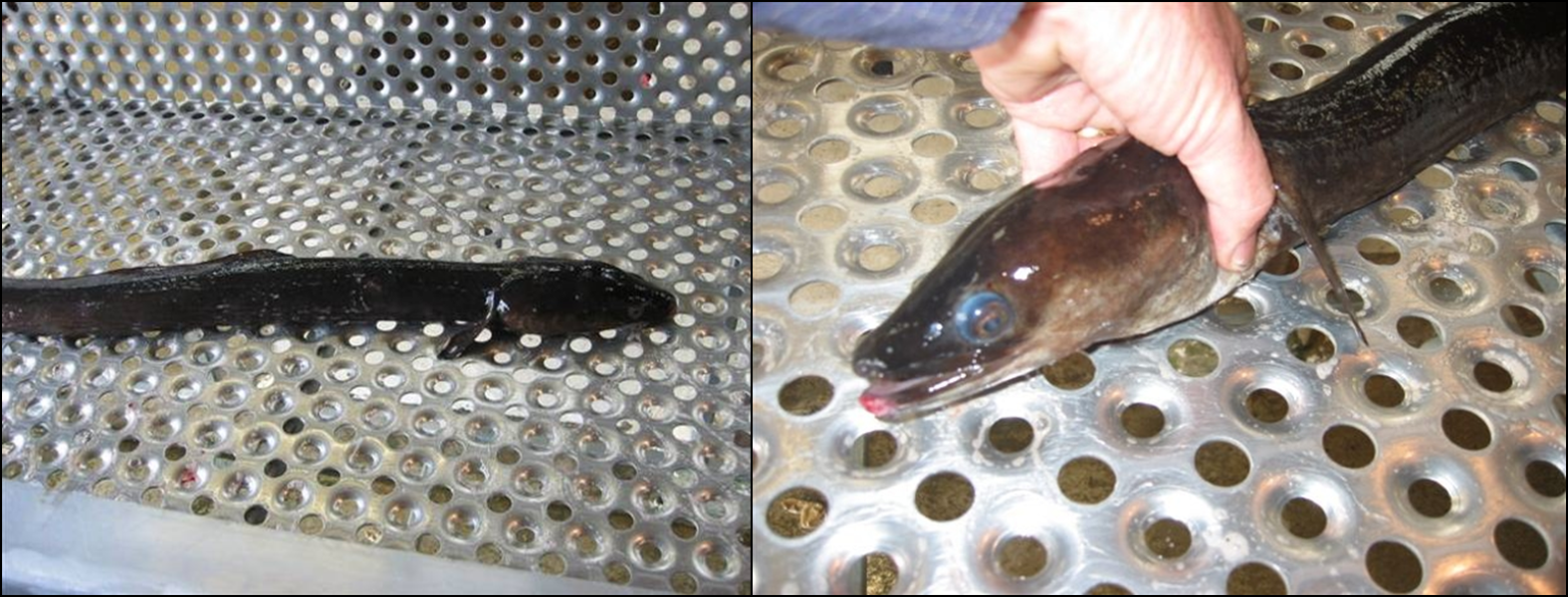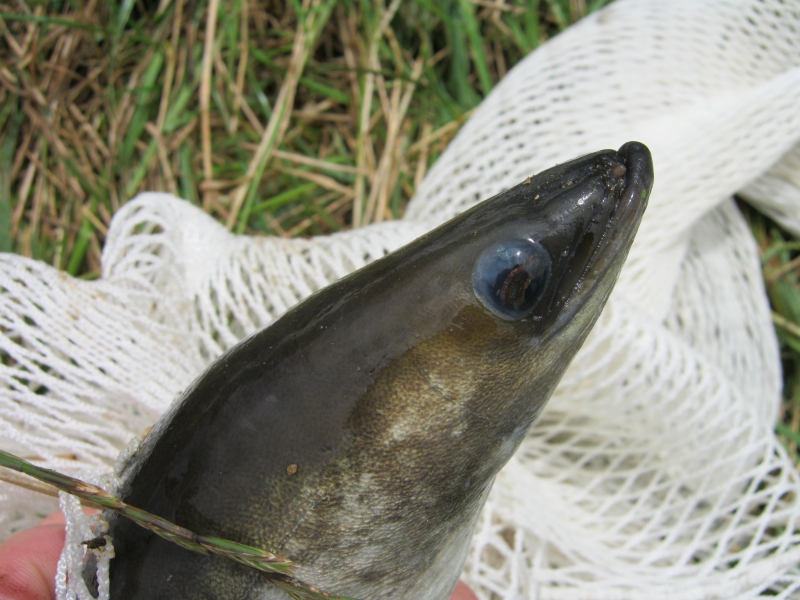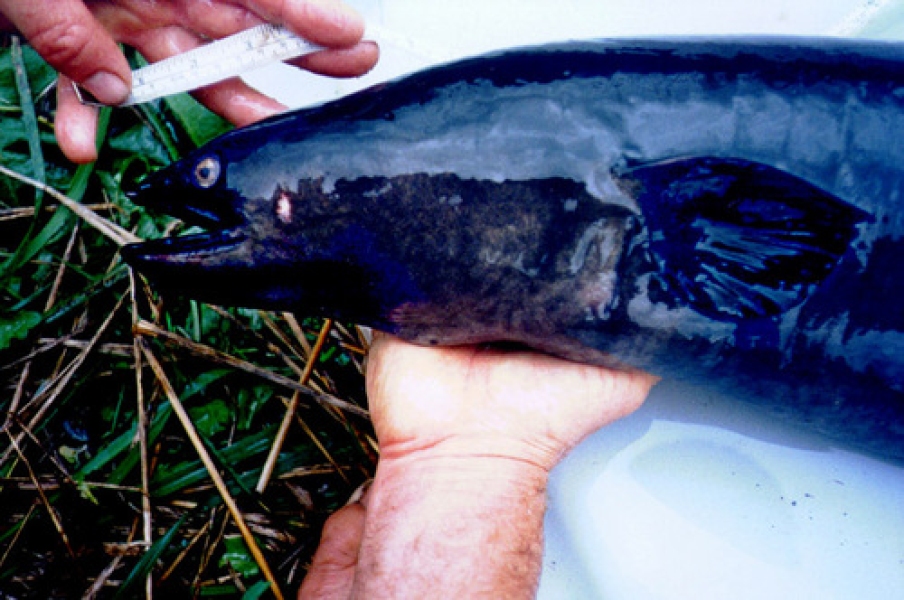Every year, a proportion of eels mature and migrate to sea to spawn.
Once eels become migrants (also known as tuna heke or tuna whakaheke) they stop feeding, and progressively develop the external features that clearly distinguish them from 'feeders'. These features include:
- the head becoming flatter and more slender (bullet shaped)
- lips becoming thinner
- darkening of the pectoral fins, head and back
- the belly lightening to a grey or silver colour.
In addition, the pectoral fins and eyes enlarge and become surrounded by a narrow (sometimes bluish) ring.
Downstream migrations normally occur at night during the dark phases of the moon, and are often triggered by high rainfall and floods. During the migration to the oceanic spawning grounds, eels do not feed but instead rely upon stores of body fat to sustain them during the 6 month (or so) journey. There is a specific pattern in the sequence of seaward migrations with the smallest, shortfin males migrating during February and March, followed by shortfin females in March and April. Longfin males migrate during April, followed by longfin females from late April to June.
By the time they spawn, eels are thin and they die shortly afterwards. While it is possible to spawn eels in the laboratory by giving them injections of different hormones, rearing the delicate larvae through to the glass eel stage has only been achieved within the last few years: large-scale hatchery production of glass eels is still many years away.
Protect the big girls!
Larger female eels are much more fecund (contain more eggs) than smaller female eels and are likely to make a greater reproductive contribution by producing a higher proportion of eggs for potential recruitment to New Zealand waters. However, female longfin eels are long-lived and take several decades to reach reproductive maturity. Until they reach maturity and migrate to sea, tuna (and particularly the females) are susceptible for a long period of time to fishing activities as well as mortality due to by non-fishing activities, such as drainage clearance and pollution events, and natural causes (e.g., predation, disease).
The level of egg production to ensure sufficient recruitment of eels is unknown. However, there are concerns about a decline in the number of large longfin female eels in the fishery and what impact this might have on spawning escapement.
An assessment of the size and age structure of eel populations in the 1990s emphasises that the number of large (>700 mm) female longfin eels has significantly reduced in comparison to observations made prior to, or during, the 1970s. Additionally, the length frequency distributions of eels caught by commercial fishers in recent years throughout the country shows that fewer large eels are being caught.
There is a low level of escapement of longfin eels from fished areas. However, it is likely that eel populations in unfished areas contribute a greater proportion of large migrant females to the spawning population. The exact proportion of eels escaping to spawn from fished and unfished areas is unknown.
When adults eels become sexually mature, they begin to change their physical appearance and some of their features, in preparation for travelling to and swimming in the ocean - a very different environment to freshwater. Examples of these changes include: their fins and eyes get bigger (to make swimming in currents easier, and to have better vision in low light) and the belly becomes more silver (to make them less visible to predators swimming beneath them). If they are unable to reach the sea due to, for example, being blocked by something, a migrant who has undergone these changes can either "change back" (and start eating again) or will start to waste away as they may have changed too much to continue to survive in freshwater.
Escapement - sexually mature migrants need to be able to get to the sea. Thus, escapement is a fisheries term used to describe the stock surviving fishing pressures over a spawning cycle. In this case we use it to describe the number of eels "escaping" or travelling/swimming freely from pressures (like commercial fishers and hydroelectric dams) to get to the ocean and complete their life cycle.
References and further reading
Beentjes, M.P., Boubée, J.A.T., Jellyman, D.J., Graynoth, E. (2005). Non-fishing mortality of freshwater eels (Anguilla spp.). New Zealand Fisheries Assessment Report 2005/34. Ministry of Fisheries, Wellington. 38 p. http://fs.fish.govt.nz/Doc/17219/2005%20FARs/05_34_FAR.pdf.ashx
Beentjes, M.P., Jellyman, D.J., Kim, S.W. (2006). Changing population structure of eels (Anguilla dieffenbachii and A. australis) from southern New Zealand. Ecology of Freshwater Fish 15: 428-440. http://onlinelibrary.wiley.com/doi/10.1111/j.1600-0633.2006.00165.x/full
Boubée, J.A.T., Mitchell, C.P., Chisnall, B.L., Bowman, E.J., Haro, A. (2001). Factors regulating the downstream migration of mature eels (Anguilla spp.) at Aniwhenua Dam, Bay of Plenty, New Zealand. New Zealand Journal of Marine and Freshwater Research 35: 121-134. http://www.royalsociety.org.nz/publications/journals/nzjm/2001/009/
Cairns D. (1941). Life history of the two species of New Zealand freshwater eel. Part I. Taxonomy, age and growth, migration and distribution. New Zealand Journal of Science and Technology Series B 23: 53-72.
De Silva, S.S., Gunasekera, R.M., Collins, R.O. (2002). Some morphometric and biochemical features of ready-to-migrate silver and pre-migratory yellow stages of the shortfin eel of south-eastern Australian waters. Journal of Fish Biology 61: 915-928. http://onlinelibrary.wiley.com/doi/10.1111/j.1095-8649.2002.tb01852.x/abstract
Durif, C.M., Travade, F., Rives, J., Elie, P., Gosset, C. (2008). Relationship between locomotor activity, environmental factors, and timing of the spawning migration in the European eel, Anguilla anguilla. Aquatic Living Resources 21: 163-170. http://journals.cambridge.org/action/displayAbstract?fromPage=online&aid=8207872&fulltextType=RA&fileId=S0990744008000314
Graynoth, E., Jellyman, D., Bonnett, M. (2008). Spawning escapement of female longfin eels. New Zealand Fisheries Assessment Report 2008/7. Ministry of Fisheries, Wellington. 57 p. http://fs.fish.govt.nz/Doc/10549/2008%20FARs/08_07_FAR.pdf.ashx
Jellyman, D. J. (2007). Status of New Zealand fresh-water eels stocks and management initiatives. ICES Journal of Marine Science 64: 1379-1386. http://icesjms.oxfordjournals.org/content/64/7/1379.full.pdf
Jellyman, D.J., Todd, P.R. (1982). New Zealand Freshwater Eels: Their Biology and Fishery. Information Leaflet 11. Fisheries Research Division, New Zealand Ministry of Fisehries. 19 p.
Larsson, P., Hamrin, S., Okla, L. (1990). Fat content as a factor inducing migratory behaviour in the eel (Anguilla anguilla L.) to the Sargasso Sea. Naturwissenschaften 77: 488-490.
McDowall, R.M. (1990). New Zealand Freshwater Fishes - A Natural History and Guide. Heinemann Press, Auckland.
Slone, R.D. (1984). Preliminary observations of migrating adult freshwater eel (Anguilla australis australis Richardson) in Tasmania. Australian Journal of Marine & Freshwater Research 35: 325-339. http://www.publish.csiro.au/?act=view_file&file_id=MF9840471.pdf
Todd, P.R. (1980). Size and age of migrating New Zealand freshwater eels. New Zealand Journal of Marine and Freshwater Research 14(3): 283-293. http://www.royalsociety.org.nz/publications/journals/nzjm/1980/036/
Todd, P.R. (1981). Morphometric changes, gonad histology, and fecundity estimates in migrating New Zealand freshwater eels (Anguilla spp.). New Zealand Journal of Marine and Freshwater Research 15: 155-170. http://www.royalsociety.org.nz/publications/journals/nzjm/1981/018/
Todd, P.R. (1981). Hormone-induced maturation in male New Zealand freshwater eels (Anguilla spp.). New Zealand Journal of Marine and Freshwater Research 15: 237-246. http://www.royalsociety.org.nz/publications/journals/nzjm/1981/026/



